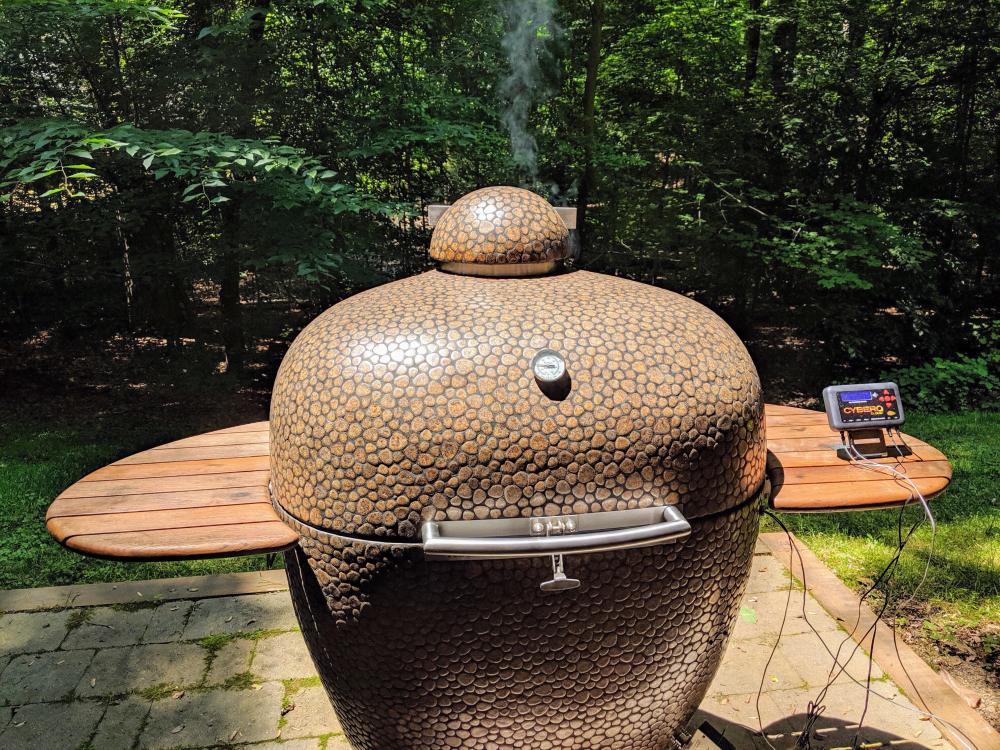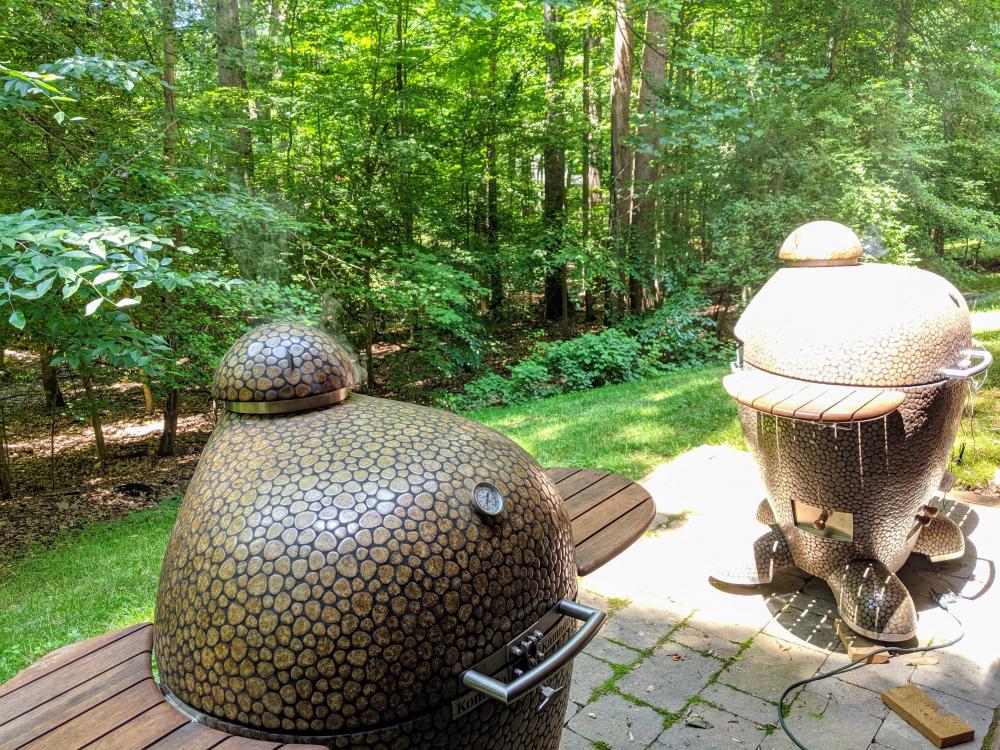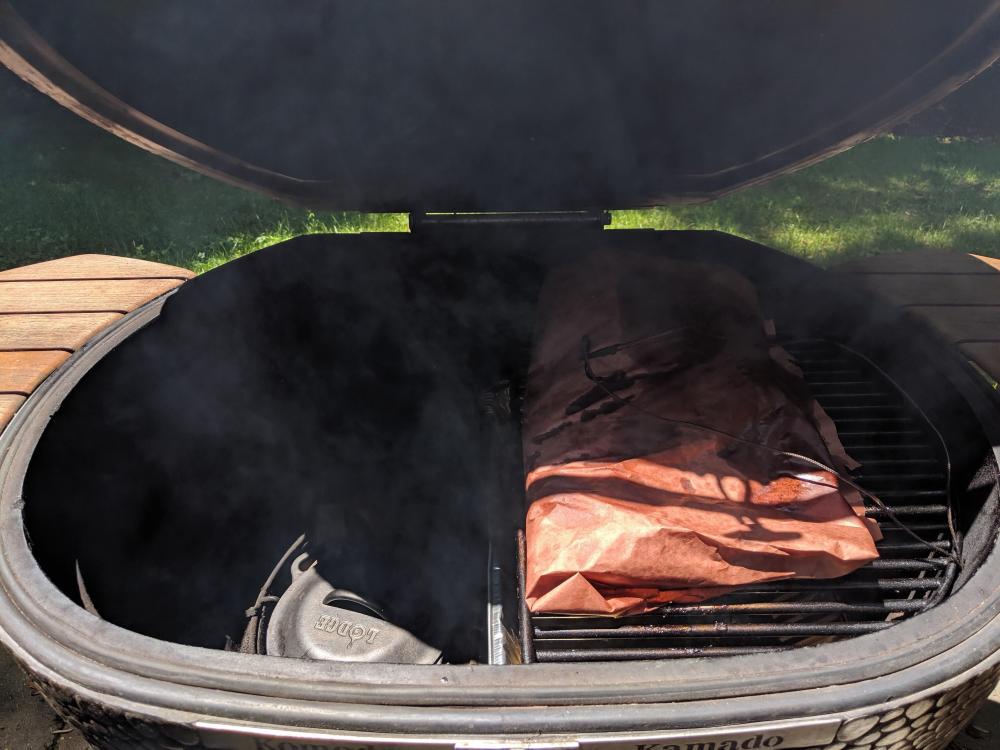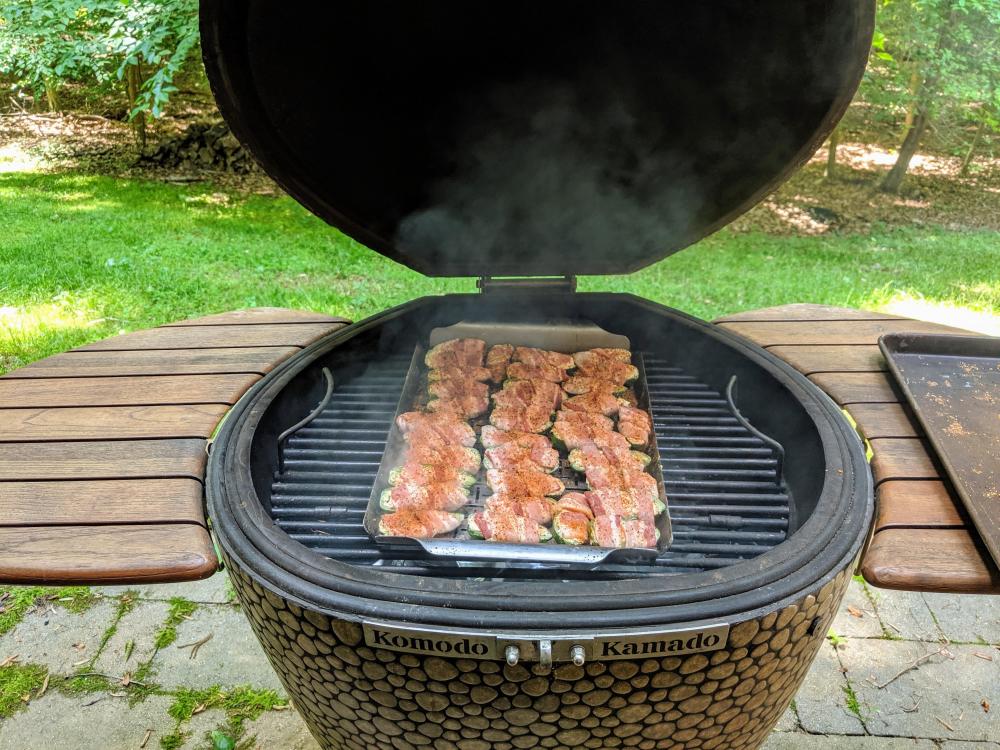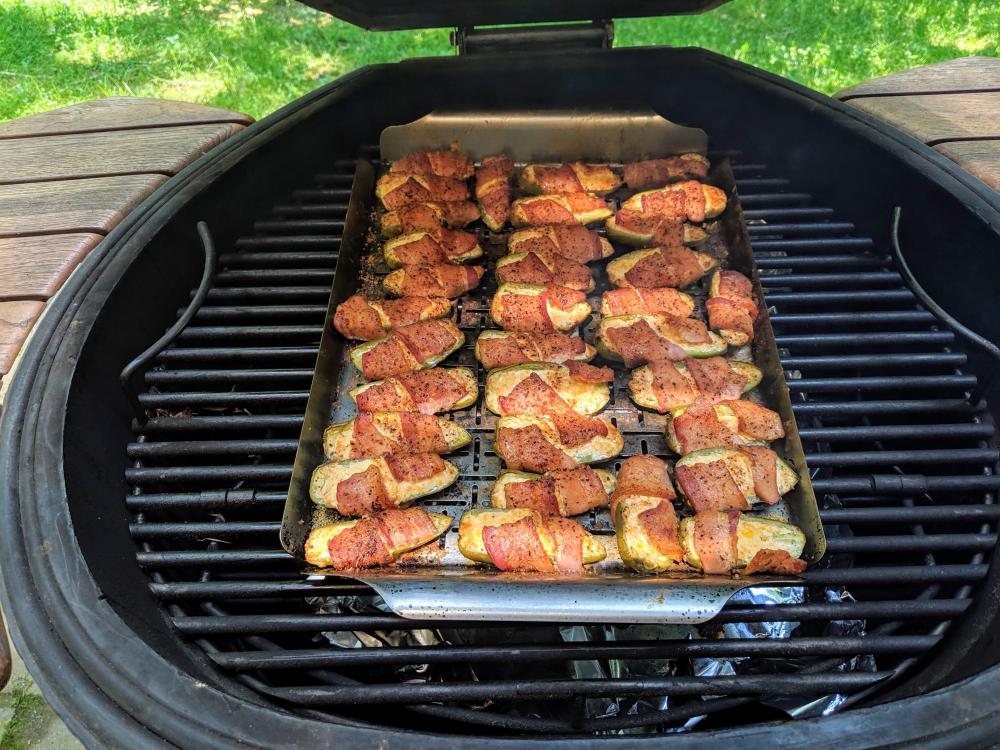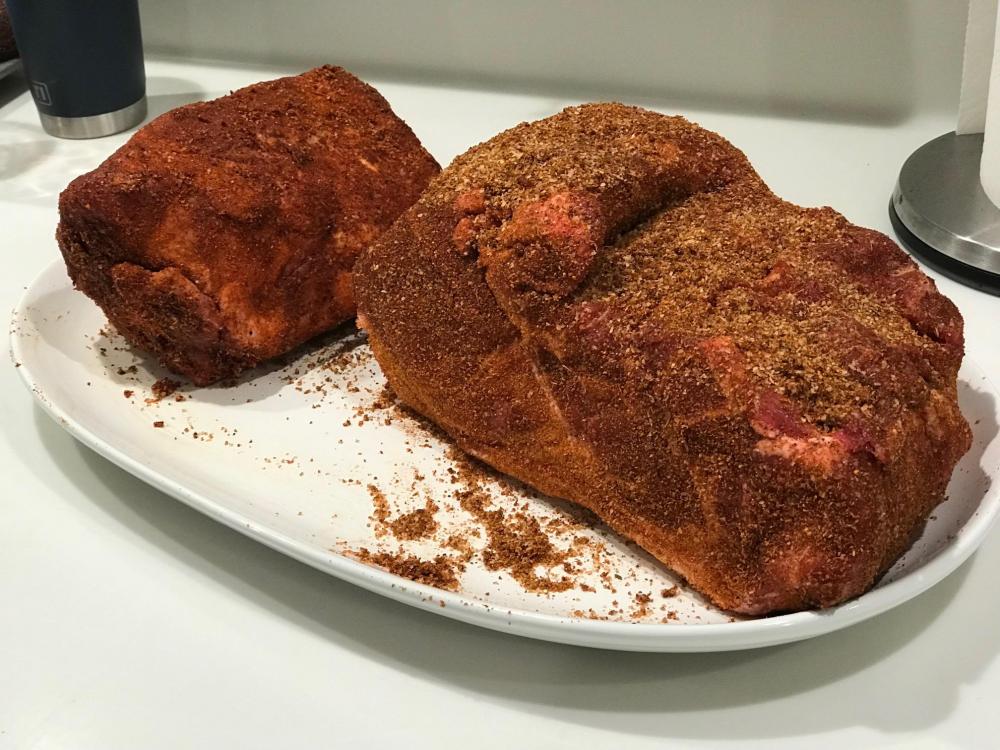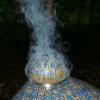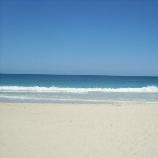Leaderboard
Popular Content
Showing content with the highest reputation on 05/25/2019 in all areas
-
Wife has to work on the actual day, so doing our cook today and having guests. Full arsenal today. The 32 smoking a brisket. Fired up the coals last night, hence the CyberQ to hold it at low temp overnight. Then ramped it up this AM for a Franklin style brisket using the smoke pot over coco char. Bad lighting, but the boys together. And on the 23 we have some ABT’s over coco char with apple wood. More later if I remember pics. Cooked ABT’s.6 points
-
4 points
-
Remember I described precooking ribs in the PC and then finishing on the fire? I pressure cooked a 6-1/2 lb. boneless pork shoulder, elevated off the bottom of the pot with a trivet, for 30 minutes, and waited for a natural pressure release. It’s now smoking on an oak/mesquite fire. Once I see a good bark I will wrap it in butcher paper until it hits an internal temp of 205°F. The fire is running at about 275°F. The experiment is to see if you can get it done in less than 1-1/2 hour per pound, ( 9-3/4 hours for this one) and get a good result. Standby...3 points
-
Very good question. It's important to NOT clip the temperature probe to the grate with anything metal or it will give you an erroneously high temperature to the controller. As far as I know, no one's software tries to account for this. BBQ Guru sells a "probe tower" to address this issue. Being a cheap-ass, I have fashioned myself a nice holder out of used wine corks (of which I have plenty!) Just trim a little off of each side on one end until it fits between the grate rods. I've then screwed a small screw in the other end to clip the alligator clip on my temperature probe to. The cork provide sufficient insulation that your probe is sensing actual air temperature and giving you a better idea of the cooking temperature for an indirect low & slow cook. Here's a picture of it. This is an older version where I was using a half of a toothpick, but they burned up after only one or two cooks, so I later switched to the small screw. Found a second picture of one that was a new cork.3 points
-
The key difference between the two sides -- direct and indirect -- is the heat transfer rate, not the temperature. I want a much lower heat transfer rate on the indirect side than on the direct side. Food cooks by energy being transferred to it, not by the surrounding temperature. That seems a bit counter-intuitive because we set our ovens and grills, etc. to a temperature, not a heat transfer rate. But bear with me. This next bit is going to get a bit technical. Can't help myself -- being an engineer who once upon a time did fluid dynamics and heat transfer for a living (mostly over that now, having moved on to other, geekier things). Feel free to skip it. Ahem. There are three fundamental mechanisms of heat transfer: Conduction, convection, and radiation. All are always present. The overall heat transfer is the sum of the three. None is superior to the other, although one may clearly dominate in certain cases. Examples: Conduction: food on a griddle or in a hot pan is cooked by conduction. We use the knob on the stove -- low, medium, high to tell us how hot it is (given time to reach equilibrium). When our grill grates get hot and we get grill marks on our food, this was achieved by conduction -- direct contact of the food with the grate. Note that the grate itself may be considerably hotter than the temperature reading on the grill. This is because the grate was heated, in part, by radiation...which doesn't care so much about your grill thermometer. Convection: food in an oven or on the indirect side of a grill is cooked by convection where heat is transferred by the surrounding air to the food. Sous vide cooking is similar, but the heat is transferred by water. In both cases, the temperature of the fluid medium matters because the temperature determines the heat transfer rate. Note that temperature does NOT cook food. Temperature -- specifically the difference in temp between the fluid and the food -- determines the heat transfer rate which DOES cook the food. The temperature in your oven and thermometer on your grill are indicators of *convective* heat transfer, but are not the mechanism by which food itself is cooked. Radiation: Searing directly over a heat source like a bed of hot coals is mostly done by radiation. The temperature of the heat source matters, but the distance from that source determines the heat transfer rate. The thermometer on your grill doesn't measure ANYTHING related to IR heat transfer -- only the temperature of the air which contributes to convection. This is what I do too.3 points
-
Looking good. Have me a butt going on just before bed. Grill and butt is prepped and ready to go. In the mean time I'm cooking up 2 different BBQ sauces. A vinegar based and Mrs skreef's sweet girlie tomato based sauce. I might run to the store in the morning and get the ingredients for a mustard based sauce.1 point
-
1 point
-
@Pequod Nice tutorial on basic heat transfer. Flashbacks to my 1st heat transfer course as an undergrad!1 point
-
Hi, Doc! Glad to see you post. Let us know how it works out. I tried the rib idea once and it worked out fine; but, I have to say, that I haven't done it since. Hoever, it's nice to have it in your BBQ toolbox if you need to do a rack in a short period of time! Same for this pork butt, assuming it works out as well!1 point
-
1 point
-
1 point
-
Gorgeous setup Bruce! To the OP: Go big or go home... better to have more than not enough when grilling. Sent from my iPhone using Tapatalk1 point
-
I set the coals at the back for rotisserie cooking . I don't know why you would put them at the front Sent from my SM-T835 using Tapatalk1 point
-
Have posted this article before, but worth reposting here: https://amazingribs.com/more-technique-and-science/grill-and-smoker-setup-and-firing/how-control-temperature-indirect Says it better than I have: purpose of two-zone is to have one “hot” zone dominated by infrared, with the other, cooler side dominated by convection. For convection to dominate, first must have low infrared due to distance squared or IR deflector. The 23 can do the job, but in the 32 the zones are more distinct and with larger area in each zone.1 point
-
Offset is carrying its heat primarily through convection. Especially in a reverse flow offset, the firebox isn’t directly exposed to the cooking chamber, although it will be hotter and, therefore radiate. Kamados, especially KKs due to the superior insulation over glazed pots, are characterized by being low flow. Not NO flow, but low flow. Convection certainly plays a role, but not the same role it plays in an offset. Also, there is no such thing as two-zone in an offset...at least not on purpose. Goal there is even heat throughout. Two-zone is associated more with grilling, not smoking. The hot side of a two-zone grill is most definitely doing its thing via Infrared...and maybe a bit of conduction from the cooking surface which was heated via infrared.1 point
-
Congrats and welcome to the KK family even though i was in the cobalt blue corner that matte black pebble is sharp great color choice your going to love it .. Now remember lots of delivery pics when you get that beast1 point
-
Well there is that old saying “it’s better to have it and not need than to need it and not have it” i bought the BB32 and have never regretted it. These cookers are not only great grills but works of art. No matter witch one you buy I guarantee you will love it. Good luck on your choice and welcome to the forum. Looking forward to uncrating and cooking pictures.1 point



